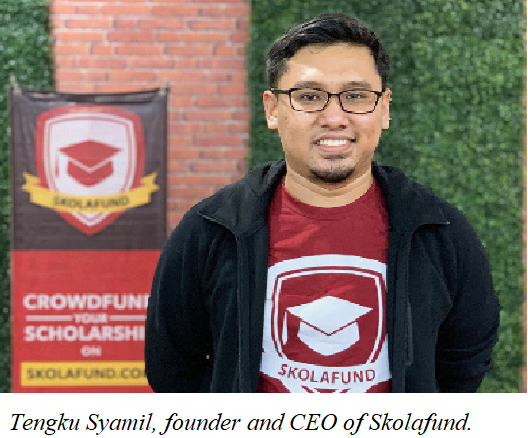SCxSC2019, Securities Commission Malaysia’s annual fintech event, is a yearly affair that industry folk have come to look forward to for the discussion and networking opportunities it offers. The agenda over the course of the two-day conference (October 22 & 23) featured a track of sessions named SC Digital Initiatives aimed at giving attendees more insight into alternative financing and investments.

Just like the year before, Elain Lockman (pic, above), the cofounder of Ata Plus and president of the Registered Digital Market Association of Malaysia, took to the stage to present the latest report card of equity crowdfunding (ECF) in the country for 2018/19.
Read Also: Skolafund Becomes First ECF Exit in Malaysia
Three exits invigorate ECF landscape
It was a keenly awaited moment for the fledgling Malaysian ECF ecosystem – its first exit story. And 2019 has given the industry three such stories says Elain.
The first came through just recently, on 9th Oct, with the news  that social enterprise, Skolafund, which itself is a crowdfunding platform sourcing for scholarships for the needy was fully acquired via one of the largest donation crowdfunding platforms in Asia. The acquisition provided a 10% return to Skolafund’s ECF investors though the investor chose to keep their identity private.
that social enterprise, Skolafund, which itself is a crowdfunding platform sourcing for scholarships for the needy was fully acquired via one of the largest donation crowdfunding platforms in Asia. The acquisition provided a 10% return to Skolafund’s ECF investors though the investor chose to keep their identity private.
Skolafund raised US$71,600 (RM300,000) in 2017 from 26 individual investors and holds the record for smallest investment entry size of RM10 among Malaysian ECF issuers.
And just last week, the ECF ecosystem got its second exit when Mycash Online saw Silicon Valley-based venture capital firm 500 Startups offering to buy out its ECF investors, giving them returns of 44.2% two years after the ECF deal on PitchIN.
“Out of the 19 investors, three took up the offer while the rest chose to stay on because they see further potential for the business to grow and create value,” says Elain. And the decision by the investors that choose to remain highlights a key advantage that proponents of ECF like to stress. “This is where we see opportunity for ECF investors to come in at an early stage, especially for retail investors,” shares Elain.
The third exit highlighted is a biotech company, Greenlagoon, but is not really a traditional exit. One of the very first companies that raised funds via ECF with US$191,000 (RM800,000) raised from 24 investors from Crowdplus.asia, it has completed two renewable energy projects with two more in the pipeline.
“Their deal was a bit different – they have a buyback option as well as annual dividends. They have been giving out dividends of about 6% to investors,” shared Elain. Three years after its ECF deal, 11 out of 24 ECF investors took up the share buyout offer with 100% returns.
The 2019 ECF snapshot
“To date, we have had 70 successful campaigns and have supported 69 small medium enterprises (SMEs),” shared Elain, adding that a 75% majority of issuers are tech companies.
For 2019, the maximum amount that was raised was RM5 million, which is the maximum limit set for companies raising their second funding round, while the smallest amount raised by any issuer was RM 50,000.
[RM1 = US$0.24]
Inferring from data shared in the 2018 report card, it can be concluded that the amount raised this year has dipped slightly to RM21 million from last year’s RM21.6 million. As for 2016 and 2017, totals raised were RM8 million and RM17.1 million respectively.
“There has been a slight drop compared to last year but the numbers of published campaigns have increased,” Elain shared, attributing the slight decrease to smaller campaign amounts raised. In 2019, there were 29 successful campaigns compared to 19 campaigns in 2018.
Shifting investor age demographic
As for investor demographic, Elain highlighted an increase in participation by sophisticated investors from last year’s 25 to 29 investors this year, corresponding closely to a 14% rise in involvement from the Baby Boomer generation. “Obviously, as you get older, you tend to have more financial capacity to invest,” she explained.
Across the board, Generation Y made up the largest proportion of investors (40%) followed closely by Generation X (35%). By gender, the proportion of female (29%) to male investors (71%) remain unchanged from the previous year.
Outlook on the horizon
Despite the RM600,000 dip in amount raised this year, Elain emphasised the marked increase in number of published campaigns and briefly mentioned the probable “launch of one or two secondary exchanges that can support interim exits for investors.”
Another key development in the ECF ecosystem is the support coming in from the government via the RM100 million Malaysia Co-Investment Fund (MyCIF) to invest together with private investors via ECF and P2P platforms. “To us, this is really exciting because this is proof that the government is co-investing together with the public to support up and coming companies,” hailed Elain.
MyCIF will invest in ECF campaigns based on a 1:4 ratio with a max investment of RM500,000 per campaign. With such support from the government, expect 2020 to register a much stronger performance by the ECF sector.